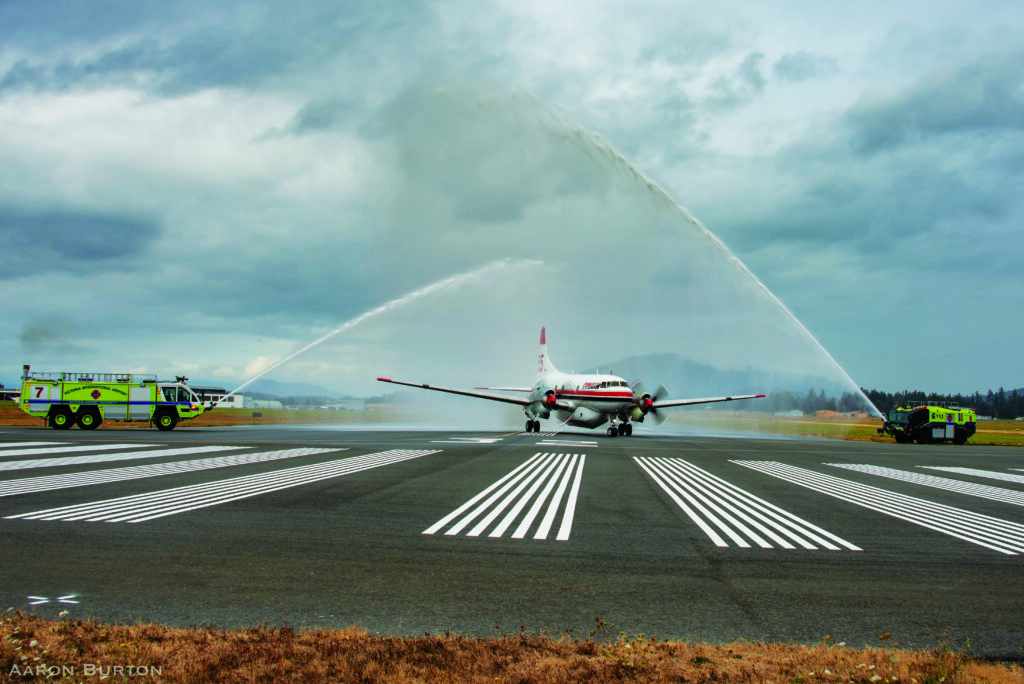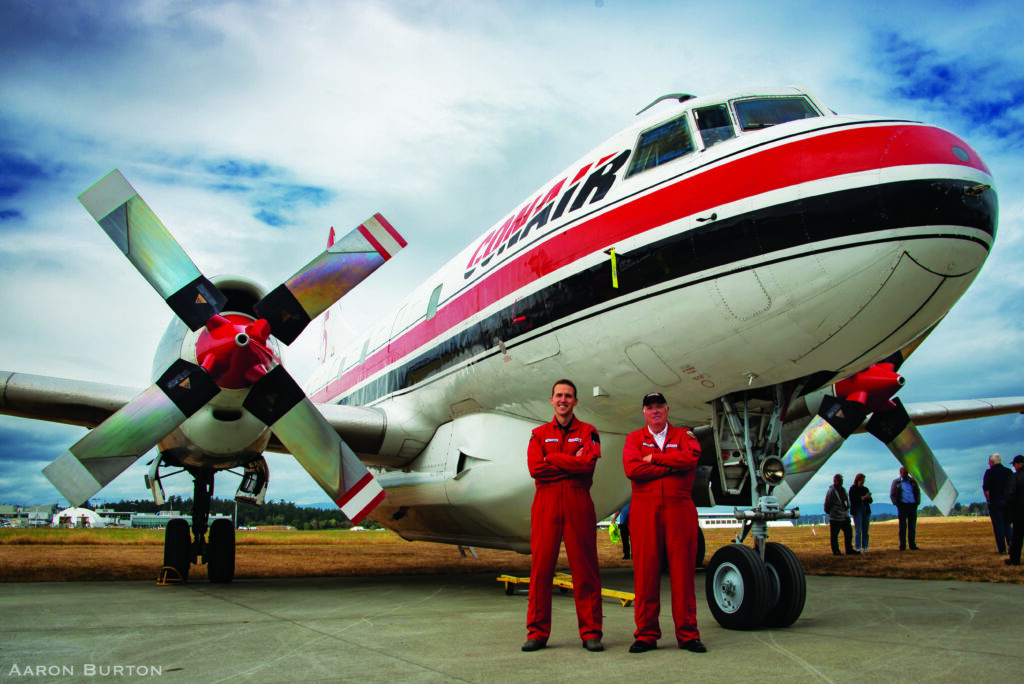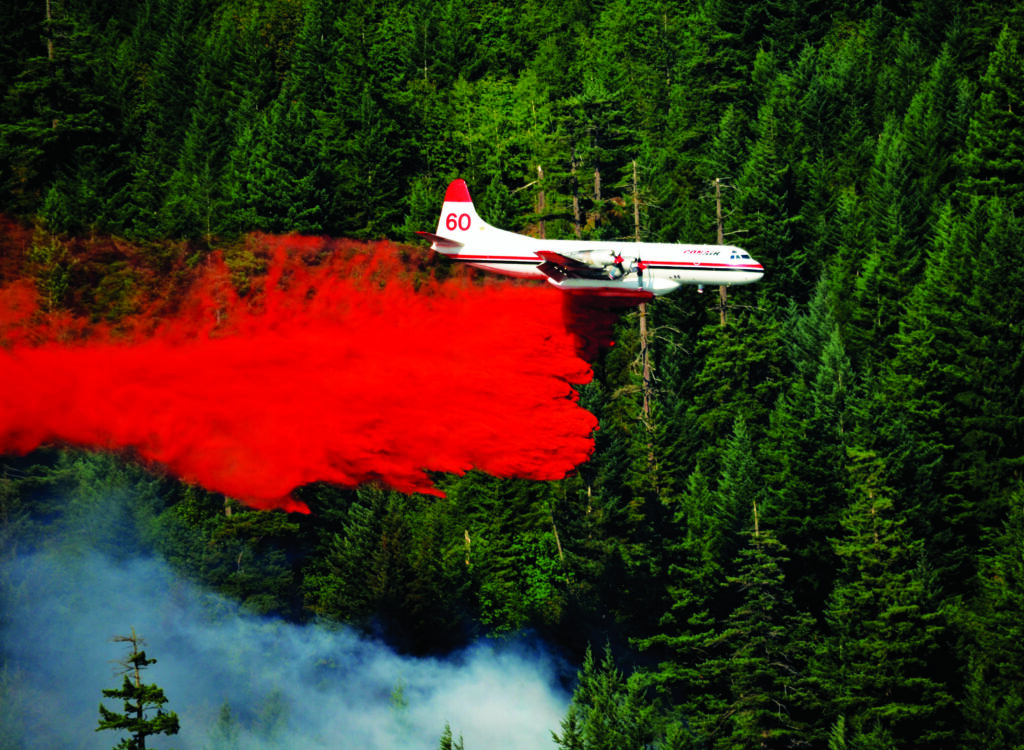Conair retires its Electra and Convair fleet, ending over a half-century of service.
Few regions of the world are left operating 60-year-old air tankers and the retirement of the last of Conair’s legacy fleet this past summer means there are now less than a dozen of these old birds still fighting fires around the globe.
“For decades, we operated one L-188 Electra and nine CV580 Convair air tankers, executing missions in western Canada and the US. But the aircraft was getting old,” said Jeff Berry, Director of Business Development at Conair. “The risk of obsolescence became critical to our continued emergency response services. We had to take the leap and modernize to ensure we can continue to offer our agency partners reliable air tankers well into the future.”
The Electra was the first to retire in 2020 after Conair converted the 1960s commercial airliner into an air tanker in the 1990s. And the last to retire was the Convair, with the remaining three air tankers finishing their contracts with BC Wildfire Service in September. “We chose to convert only one L-188 into an air tanker as the Convair offered the support of an active and local Original Equipment Manufacturer, KF Aerospace, which was key to a successful maintenance program,” shared Jeff. “There was also a larger inventory of airframes, and the CV580s were slightly more fuel efficient.”
 Like many fixed-wing aerial firefighters, the aircraft lived prior lives before becoming fire bombers, with some having more colorful histories than others. Convair Tanker 454, for instance, began 69 years of service in 1953 to airlines, freight carriers, and forest fire protection agencies. When it was only six months old, the aircraft, working for United Airlines, sustained a mid-air collision with an American Airlines Convair at 11,000′ just east of Chicago.
Like many fixed-wing aerial firefighters, the aircraft lived prior lives before becoming fire bombers, with some having more colorful histories than others. Convair Tanker 454, for instance, began 69 years of service in 1953 to airlines, freight carriers, and forest fire protection agencies. When it was only six months old, the aircraft, working for United Airlines, sustained a mid-air collision with an American Airlines Convair at 11,000′ just east of Chicago.
The collision ruptured both fuselages, but the Convairs were able to land, with only one minor injury reported. As a result of the accident investigation, FAA regulations were enacted to require rotating anti-collision lights on all aircraft over 12,500 lbs.
Any Conair pilot that flew her always commented on her need for extra attention to the rudder trim! After her incident, she returned to the airlines for passenger and freight service until 2001, when she began the final leg of her career as an aerial firefighter, joining Conair to become Tanker 454, where she spent 21 years fighting wildfires from Anchorage to Alberta to Austin, with many bases in between.
 Both the Convair and Electra were exemplary aerial firefighters, logging thousands of hours and drops over the years. “The Convair was from the age before computers were designed. It was extremely rugged and overbuilt for safety. If the Air Tractor is like the Swiss Army Knife – can do anything – the Convair was like a sledgehammer.
Both the Convair and Electra were exemplary aerial firefighters, logging thousands of hours and drops over the years. “The Convair was from the age before computers were designed. It was extremely rugged and overbuilt for safety. If the Air Tractor is like the Swiss Army Knife – can do anything – the Convair was like a sledgehammer.
 Anytime you have a plane with more power than you need, the pilot is happy,” explains Anthony Ussher, former Captain of the CV580. The tankers were basic, with interiors gutted to maximize the tank capacity. Cockpits were hotter than the temperatures outside, with only a couple of tiny fans circulating the air. “I’ve placed a thermometer in there,” said former Convair Captain Grahame “Whiskey” Wilson. “And it’s ten degrees (Celsius) hotter inside than the outside air temperature. So when it’s 40, it’s 50 in here.
Anytime you have a plane with more power than you need, the pilot is happy,” explains Anthony Ussher, former Captain of the CV580. The tankers were basic, with interiors gutted to maximize the tank capacity. Cockpits were hotter than the temperatures outside, with only a couple of tiny fans circulating the air. “I’ve placed a thermometer in there,” said former Convair Captain Grahame “Whiskey” Wilson. “And it’s ten degrees (Celsius) hotter inside than the outside air temperature. So when it’s 40, it’s 50 in here.
And on top of that, we wore Nomex flight suits.” With over 40 years of aerial firefighting experience, Grahame had flown the DC-6, Firecat, and Bird Dogs, but the Convair had been his aircraft for the past two decades. He likened the Convair to a car without power steering. “It’s cumbersome on the controls. Modern aircraft have hydraulically boosted controls like ailerons, elevators, and the rudder. But this one is all pulleys, cables, and muscle. There’s a saying in the Convair world: ‘Forget the sim, go to the gym.'”
 “The aircraft themselves were in great condition,” says Brad Belyan, Director of Maintenance at Conair. “We probably put in 8 hours of maintenance to 1 hour of flight time. These machines are meticulously maintained, receiving a complete and thorough inspection, paying attention to the smallest details every winter by our team. But inevitably, the older they get, the more problems occur. And it becomes very challenging when there is limited parts availability, especially for major equipment like landing gear and engine components. There is only one company in the world right now overhauling props.”
“The aircraft themselves were in great condition,” says Brad Belyan, Director of Maintenance at Conair. “We probably put in 8 hours of maintenance to 1 hour of flight time. These machines are meticulously maintained, receiving a complete and thorough inspection, paying attention to the smallest details every winter by our team. But inevitably, the older they get, the more problems occur. And it becomes very challenging when there is limited parts availability, especially for major equipment like landing gear and engine components. There is only one company in the world right now overhauling props.”
If the Electra or Convair were a car, they would be considered a classic, or even antique; much loved but no longer the best suited for emergency response. The average life of a firetruck is 20 years. These airframes are over 60. “Dispatch reliability is core to the firefighting business. We needed to invest in a new aircraft before airframe integrity or maintenance became an issue.” shares Jeff.
“It’s a natural evolution,” shares Larry Pahl, Director of Airworthiness Engineering at Conair. “We were looking to replace our DC-6 and Firecat fleet in the 90s, moving from piston aircraft to turbine. Now, 30 years later, we are replacing our Electras and Convairs with the Dash 8-400 air tanker, offering greater speed, efficiency, agility, and, most importantly, reliability. The Dash will be flying far into the future, retiring well after many of us at Conair!”
The last wildfire the Convairs fought occurred on September 10th, 2022, a significant fire on many levels. First, the CV580s were on loan from British Columbia to Washington state, a fantastic display of cooperation between agencies to accomplish a fast response to the Crumbacher Fire, supporting the Tonasket Fire Department, Forest Service, and DNR.
Equally notable was that this fire was the first and last fire the Convairs flew with Aero-Flite’s new Dash 8-400 air tankers. Grahame, who had trained his First Officer Jon Thomson all summer and had recently seen him move into the Captain role, flew alongside Jon on the wildfire in his CV580. Finally, it turned out to be Grahame’s last mission before retiring, with him receiving many “Hi Whiskey’s!” from the crew across both sides of the border.

Not all the retired tankers will end up in recycling, with parts being sold to remaining operators who stockpile a dwindling pool of components for future repair and replacement. Conair Tail 52 joins KF Centre for Excellence in Kelowna, British Columbia, a welcome addition to the center’s iconic aircraft collection. And Tail 55 is now living out its retirement at the British Columbia Aviation Museum, joined by Grahame, who decided to retire simultaneously. “The stars aligned,” says Grahame. “I’m over 65, and so are the airplanes. So, after 20 years of flying the Convairs, I thought it would be a perfect time to retire. I have flown 55 since 2012, and I am lucky to now show her off at the museum, working as a docent. I love the plane.”
 The fleet will be missed. Residents around tanker bases grew up with these tough planes, relying on their ability to protect them from wildfires. And the Conair crew grew their careers working on the beasts. The vintage aerial firefighters will not be forgotten, but with everything, the only constant is change. The sleek new Dash 8-400 air tankers will fill the remaining legacy fleet slots at tanker bases next summer, joining over 14 already in service worldwide.
The fleet will be missed. Residents around tanker bases grew up with these tough planes, relying on their ability to protect them from wildfires. And the Conair crew grew their careers working on the beasts. The vintage aerial firefighters will not be forgotten, but with everything, the only constant is change. The sleek new Dash 8-400 air tankers will fill the remaining legacy fleet slots at tanker bases next summer, joining over 14 already in service worldwide.


